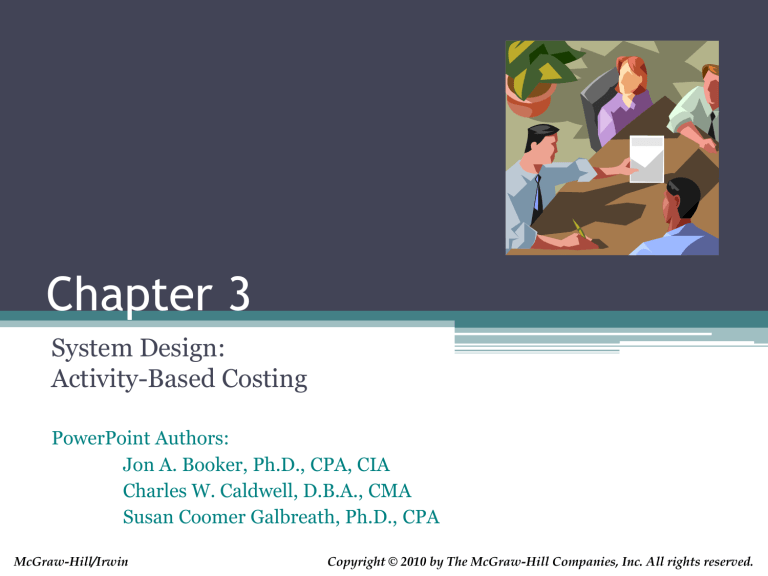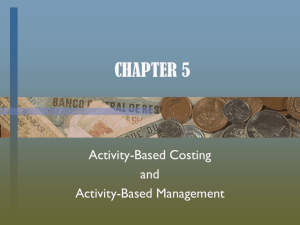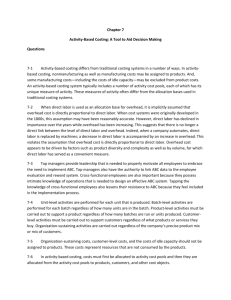Introduction to Managerial Accounting

Chapter 3
System Design:
Activity-Based Costing
PowerPoint Authors:
Jon A. Booker, Ph.D., CPA, CIA
Charles W. Caldwell, D.B.A., CMA
Susan Coomer Galbreath, Ph.D., CPA
McGraw-Hill/Irwin Copyright © 2010 by The McGraw-Hill Companies, Inc. All rights reserved.
3-2
Plantwide Overhead Rate
Plantwide Overhead Rate
A single overhead rate used throughout an entire factory.
Direct labor has often been used as the allocation base for overhead because:
1.
Direct labor information was already being recorded.
2.
Direct labor was a large component of product costs.
3. Managers believed direct labor and overhead costs were highly correlated.
3-3
Departmental Overhead Rates
Many companies have a system in which each department has its own overhead rate.
Machining Department
Assembly Department
Shipping Department
The allocation base depends on the nature of the work performed in each department.
In the machining department, overhead may be based on machine-hours, but in the assembly department, overhead may be based on labor-hours.
3-4
Activity-Based Costing (ABC)
Activity
An event that causes the consumption of overhead resources
Examples of Activities
Setting up machines
Admitting hospital patients
Billing customers
Opening a bank account
3-5
Activity-Based Costing (ABC)
For each activity in isolation, this system works exactly like the job-order costing system described in Chapter 2.
A predetermined overhead rate is computed for each activity and then applied to jobs and products based on the amount of activity consumed by the job or product.
3-6
Graphic Example of
Activity-Based Costing
Various Manufacturing Overhead Costs
First-Stage Cost Assignment
Labor
Related Pool
Machine
Related Pool
Setup
Pool
Production
Order Pool
Parts
Admin. Pool
General
Factory Pool
3-7
Graphic Example of
Activity-Based Costing
Various Manufacturing Overhead Costs
First-Stage Cost Assignment
Labor
Related Pool
Machine
Related Pool
Setup
Pool
$/DLH
Production
Order Pool
Parts
Admin. Pool
General
Factory Pool
$/MH
Second-Stage Allocations
$/Setup $/Order $/Part Type $/MH
Unit-Level
Activity
Products
Batch-Level
Activity
Product-Level
Activity
Facility-Level
Activity
3-8
Targeting Process Improvements
An ABC system can help identify areas where the company can benefit from improving its current processes.
Activity-Based Management
Focuses on managing activities to eliminate waste and reduce delays and defects.
3-9
Targeting Process Improvements
The first step in any improvement program is deciding what to improve.
The Theory of Constraints approach targets the highest impact improvement opportunities.
Activity rates can be used to target areas where costs seem excessively high.
Benchmarking can be used to compare activity cost information with world-class standards of performance achieved by other organizations.
3-10
Benefits of Activity-Based Costing
ABC improves the accuracy of product costing by:
•
Increasing the number of cost pools used to accumulate overhead costs.
•
Using activity cost pools that are more homogeneous than departmental cost pools.
• Assigning overhead costs using activity measures that cause those costs, rather than relying solely on direct labor hours.
Activity-based costing also highlights activities that could benefit most from process improvement efforts, such as Six Sigma.
3-11
Limitations of Activity-Based Costing
Costs of implementing an ABC system may outweigh the benefits. However, the benefits are more likely to be worth the costs when:
1. Products differ substantially in volume, batch size, and in activities required.
2. Conditions have changed substantially since the existing cost system was established.
3. Overhead costs are high and increasing and no one seems to understand why.
4. Management does not trust the existing cost system and it ignores data from it when making decisions.
3-12
Cost Flows in an ABC System
The flow of costs through Raw Materials,
Work in Process, and other accounts is the same under activity based costing.
The only difference in activity based costing is that more than one predetermined overhead rate is used to apply costs to products.
3-13





